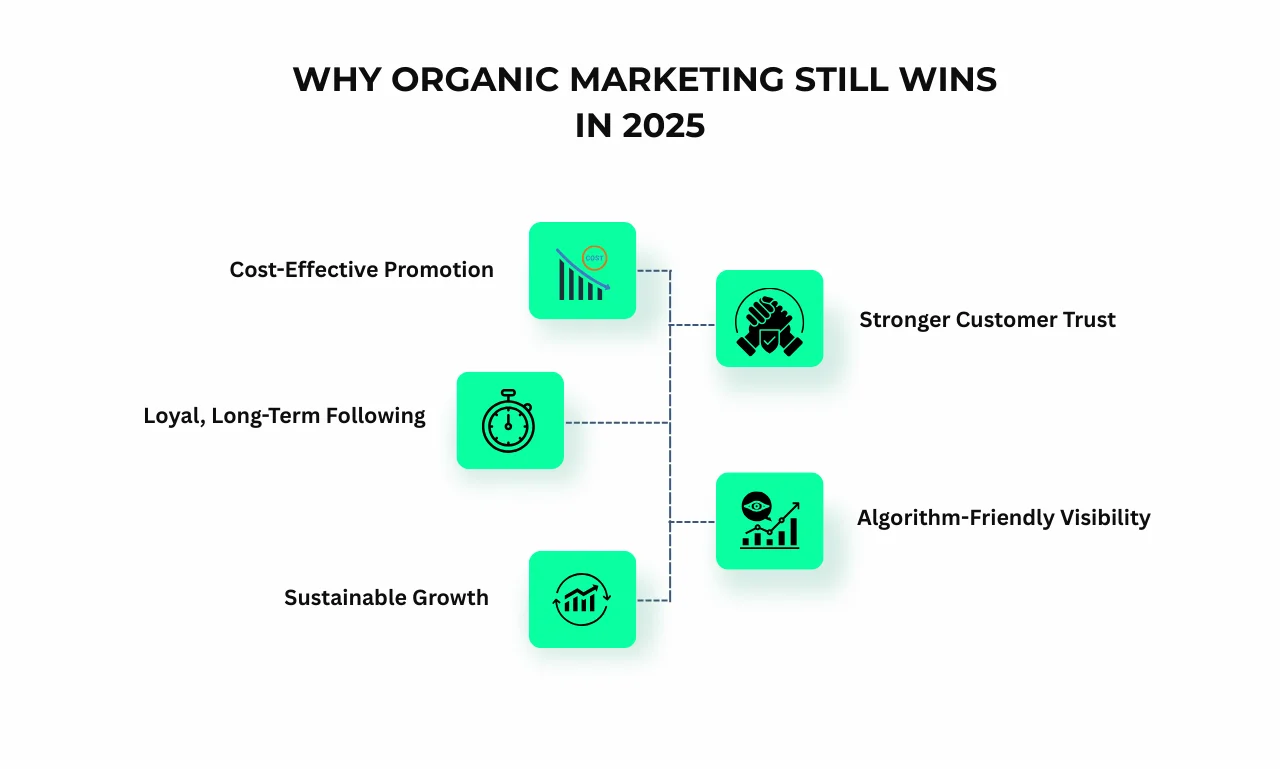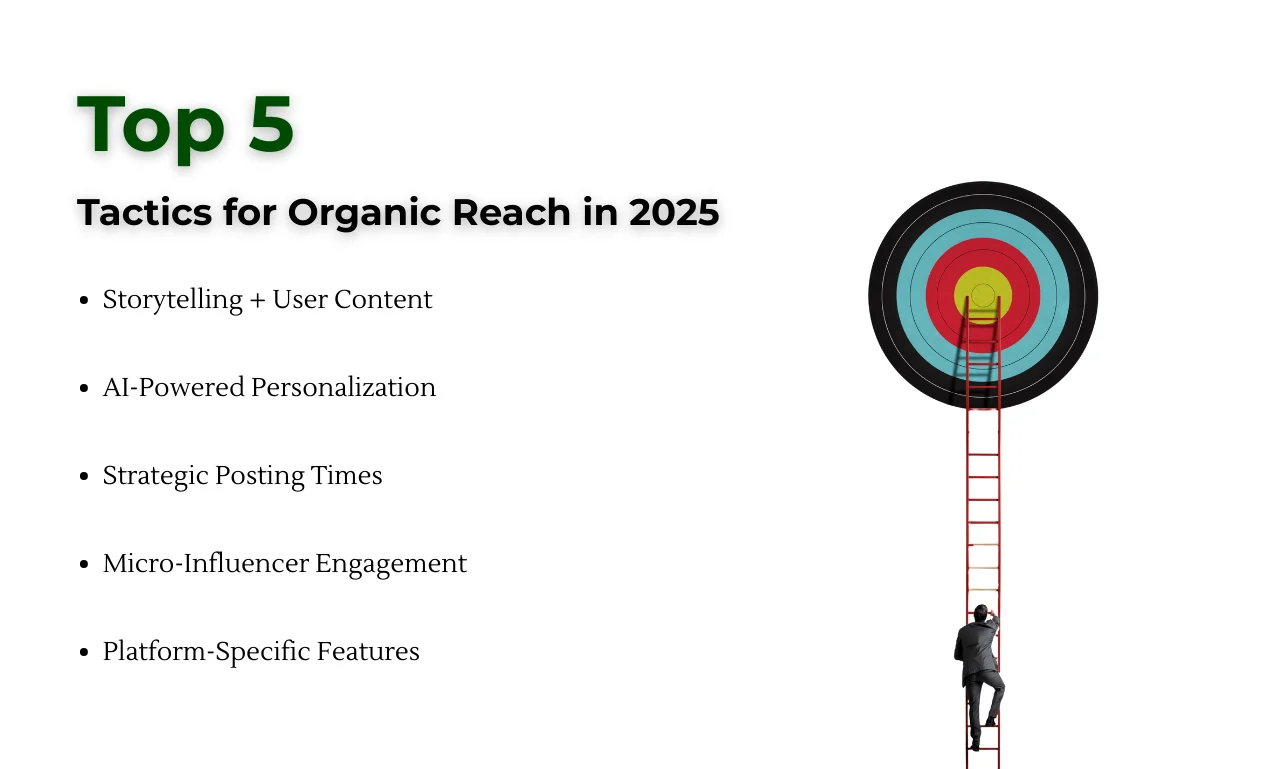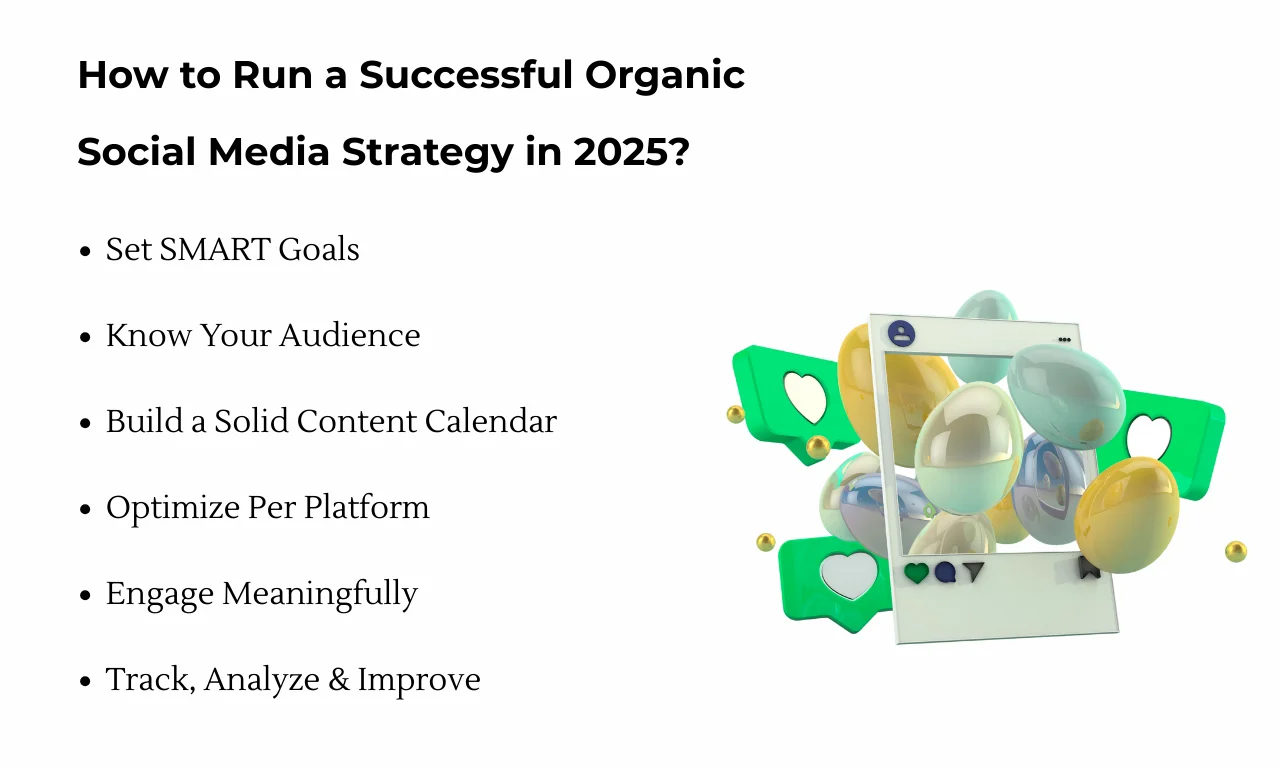As the world becomes a global village due to advancements in technology, in that scenario, management of effective organic social media marketing stands out to be one of the most important strategies that every business must engage in for the growth of its clientele base.
When it comes to the discussion about the future of the organic social media marketing strategy towards 2025, it is highly crucial to look at the innovations, changes in the platforms, management, and shifts in users’ behavior.
In this blog, we aim to discuss the concept of organic social media marketing and the direction it is likely to take in the future.
1. What Is Organic Social Media Marketing?
Organic social media marketing can be defined as the process of establishing and developing a brand on social networks and sites by using only natural methods, excluding paid advertisements. This strategy is based on building actual conversations and developing communities that revolve around your brand.
Key Components of Organic Social Media Marketing:
Here are three major components of organic social media marketing that play an important part in lead generation, conversion rate, and traffic.
- Authenticity: Sharing truthful and relevant information and using online platforms to have continuous interactions with the audience in the context of the conversation, and expressing gratitude to the followers.
- Content Development: Creating content for the target market that will offer value to those reading it. This may include posts, videos, stories, or any other multimedia that targets gaining attention and generating a response from the audience.
- Community Building: It involves using branding tactics to encourage people to contribute to your product, hosting events, and promoting a place where people feel appreciated.
Evolution of Organic Marketing in 2025:
The changes in the algorithms of social media platforms are constantly being reviewed to standardize what is deemed more appropriate for users. By 2025, the best ways of achieving this form of exposure organically will depend on the functioning of these algorithms.
- AI-Derived Content: AI will be widely used in creating and sharing the content. This will help to track down more target groups and create greater relevance of content to the audiences for higher engagement rates.
- Trends of User Activities: Because of the increasing demand of the users, there is a trend that customers tend to go with content that is real and not just fabricated. The brands that are open to such changes will be suitable to attract more organic traffic.
2. Organic vs. Paid Social Media Marketing: Key Differences
It is very important to know the difference between organic and paid activities in social media marketing. This is a comparison of the main distinctions:
Organic Social Media:
- Major aspect: The major aspect is building genuine relationships with customers and sustained development. Organic marketing involves creating value to achieve marketing objectives that grow with the audience.
- Strategy: Success hinges on high-quality content, effective SEO, and active community interaction. To keep the audience engrossed, it is necessary to develop consistency and try to be creative with the content presented.
- Outcomes: Even though this technique may be somewhat less effective than paid methods, it guarantees long-term and unconditional adherence to the customers.
Paid Social Media:
- Strengths: Paid SMM is an instantaneous method of posting that uses the paid advertisement section and sponsored posts. It is used to give the highest chance of sales and measurable results.
- Strategy: This approach entails paying for advertising to get more traffic to the posts. Some of the paid campaigns can be very specific in demographic-based, interest-based, and behavior-based.
- Effects: To get the desired results, most paid tactics will target the right audience on an organization’s website and provide instant exposure at an expensive cost.
Why a Hybrid Approach Is Optimal in 2025?
By the year 2025, most brands will incorporate two kinds of social media marketing, either organic or paid systems. This is why we consider this approach advantageous:
- Integrated Approach: Through the use of both paid efforts and organic means, brands can achieve higher visibility.
- Cost Efficiency: Unfortunately, paid marketing can be costly at times, but using organic marketing can extend the budget to the extent of using different free engagements.
- Paid Promotions: The paid campaign will help in getting traffic in the beginning to the dedicated page. However, the organic approach will be very useful in getting the traffic engaged and ultimately converting the distinct users into loyal customers.
- Flexibility: The remote-beneficial-synchronous communication strategy is flexible because you can adjust your tactics according to various factors.
3. Why Organic Marketing Still Wins in 2025?
Here are some key benefits of organic social media marketing in 2025 that surely help your brand in different ways:
1. Affordable Method of Brand Promotion:
One major benefit that goes hand in hand with using social media marketing is the fact that it is relatively cheap. Organic marketing does not entail a lot of investment as compared to paid advertising because it enables businesses to employ funds in other areas. This will prove beneficial for small and medium enterprises that are seeking to maximize their returns.
2. More Reliable Connection:
The audience feels a more reliable connection with a brand they are already engaged with on social media. By 2025, customers will become wiser and more loyal to brands with whom they interact. Why? Because organic content, due to its higher quality, helps the customers to create better relationships and brand image with the targeted audiences.
3. Long-Term Audience Loyalty:
Focused, valuable, and productive social media communications with the audience ultimately lead to long-term loyalty. Whereas, by 2025, there will be more emphasis on building a devoted fan base for your brand that will ensure that your customer base and sales are always on the rise.
4. Algorithm Benefit Preference:
Social sites work very well if a firm maintains high quality and a steady stream of posts. In this scenario, Instagram, Facebook, and TikTok, among other platforms, would have enhanced their algorithms’ capacity to cultivate genuine engagement to increase the effectiveness of organic strategies.
5. Sustainable Promotion:
Organic social media encourages brands not to solely depend on paid promotion on various platforms. Using organic approaches, your brand can achieve real engagement to get the attention of target audiences to achieve a higher conversion rate and traffic.
4. Top 5 Organic Social Media Marketing Tactics for 2025
1. Content That Resonates with Your Audience
Storytelling, User-generated Content (UGC), and Interactive Posts:
It is always important to ensure that you create material that your target consumers will be able to relate to. In the year 2025, storytelling, user-generated content (UGC), and interactive posts will rule the roost when it comes to content marketing. Here are some aspects you need to consider to generate high-quality content:
- Give speeches that move the people. Get personal with your audience by sharing how your business evolved. Share your client’s success stories and the company’s stories that are interesting to your target consumers.
- Request your audience to create content about the brand. Besides, it also gives users certain feelings of identification with the site and its material.
- Ensure that you make use of post reactions, polls, quizzes, and live Q&A, among other features. Through this, you can generate higher interactivity with your clients. Moreover, you can also get more insights into clients’ preferences.
Leveraging AI for Personalized Content Recommendations:
Another factor that will be critical in the process of applying the plan will be using artificial intelligence for customized content recommendations. Chatbots that use artificial intelligence will assist you in the identification of user preferences and be able to deliver quality content.
2. Consistent & Strategic Posting Schedule:
It is of crucial importance to keep the posts frequent or at least consistent. So, plan your frequencies using the proper strategies.
Best Times to Post in 2025:
Don’t ignore the importance of platform-specific information. Always try to post information related to the platform audience. So, there is a necessity to use the analytical tools and define when the audiences are active, until which time you need to schedule your events.
Balancing Frequency and Quality:
Here, you need to find out how often you need to post and what kind of posts you need to provide to keep your audience interested without being overloaded with continuous updates.
3. Community Engagement & Relationship Building
One of the most significant aspects of organic social media marketing is the ability to develop and grow relationships between the company and its consumers.
Commenting & Direct Messages:
Always reply to comments on your posts and threads, as well as direct messages and mentions. This creates a culture of belonging and proves to the audience that they are valued.
Promoting with Micro-Influencers and Brand Advocates:
This involves working with genuine micro-influencers and brand advocates whose values and target customers match yours. Such collaborations do increase your outreach and also give your brand authenticity.
4. SEO-Optimized Social Media Content
By 2025, it will be important to ensure that your developed content ranks well within the social media platforms when searched for on the search engines.
Hashtags, Keywords, Alt Tags:
Make sure your posts include keywords, hashtags, and alt text. Such inclusions can guarantee that your content is seen by a larger audience than the people who follow you on your account.
Voice Search & AI:
Proper preparation is required when utilizing natural types of queries, which seem to be the leading trend due to the increased number of voice searches. AI will also play a role in social SEO, where these platforms will incorporate its features to enhance the relevant recommendations of the content and the search.
5. Leveraging Platform-Specific Features
Each of the social media platforms includes peculiarities that can be used for the further organic growth of the accounts.
IG and Twitter Reels, LinkedIn, TikTok challenges:
You always need to stay abreast of the latest in the current platform and mode of communication. For example, Instagram Reels and TikTok challenges can increase the level of engagement, while LinkedIn Articles can be effective for business professionals.
Adapting to New Algorithm Challenges in 2025:
Social platforms are active participants in developing new algorithms beginning in the year 2025. It will therefore be important to keep abreast with such changes and align your strategies to retain the visibility and attention on your brand.
5. How to Run a Successful Organic Social Media Strategy in 2025?
Step 1: Define Clear Goals & KPIs
The first step is to define goals and key performance indicators that will drive the whole process and help you determine its success later on.
They should act as the guidelines throughout the whole process of forming a strategy and enable you to identify achievement.
Setting SMART Goals:
SMART stands for Specific, Measurable, Achievable, Relevant, and Time-bound. Instead of setting a general and rather unspecific target, such as working on ‘getting more followers,’ you should work towards attaining ‘the acquisition of an additional 20 percent of the total follower base of the Instagram page within the timeframe of six months.’
Identifying Relevant KPIs
Here are some of the KPIs that would be relevant to the client:
- Engagement Rate: A sum of likes, comments, shares, and saves that the page received.
- Reach and impression: The level of exposure to content, that is, the number of users that see your content.
- Follower Increase: The speed at which more people are following your account.
- Website Visitors: The number of people who come to your site through social networks.
- Conversion: This varies with the rate at which people engage in social media activities. Then convert users to take an appropriate action, such as buying or signing up for a service.
This is a good way to keep yourself on track throughout the year and complete the set tasks effectively.
Step 2: Understand Your Target Audience
A successful social media strategy hinges on a deep understanding of your target audience. Having such information will be critical in your strategy development as it helps your brand to reinforce your identity, values, and culture.
Conduct Audience Research:
You can collect data by using Google Analytics, metrics from social networks, and questionnaires that will help to identify the main characteristics of your audience. Develop audience personas to visualize the target customers and be able to relate to them.
Monitor Competitors and Trends:
Pay attention to your competitors and trends to get a better idea of what your target audience will respond to. It will assist you in finding any potential gaps that will surely help you get many competitive advantages.
Engage with Your Audience:
Conversational engagement with your audience so that they can be a part of your message. Reply to the comments, messages you receive, and mentions to foster brand development. This engagement will help you understand what they prefer and what they want every time they are engaged.
Step 3: Develop a Content Strategy
Content is the main component within the framework of Internet technologies and applications. The main point of having a content strategy is to attract as many customers as possible.
Plan a Content Calendar:
Formulate a calendar that would help in organizing posts most effectively in advance. This will ensure you do not post sporadically while at the same time ensuring that you post on diverse topics and guidelines.
Diversify Your Content:
Share a variety of content that would help the target audience maintain their engagement. The following are some of the best strategies that can be implemented in a social media marketing plan, which include increasing the usage of photos and videos, alongside stories and infographics.
Focus on Quality and Relevance:
Always try to use quality and relevant content that is more appealing to the audience. Engage the clients and speak to their emotions to explain what your brand stands for and what it wants to achieve.
Step 4: Optimize for Each Platform
The various social media platforms are different from each other and equally have different audience bases. Adapt your content and engagement strategy according to the effectiveness you wish to have on each site.
Understand Platform Algorithms:
In our recommended sources list, some sources need to be updated, such as Facebook, Instagram, Twitter, TikTok, and LinkedIn algorithms. It will assist you in being eager and prepared in handling the contents to fit into the most visible positions.
Adapt Your Content Format:
When it comes to the content, it is crucial to have a generic format that will be adjusted depending on the platform on which it will be used. For instance, vertical videos work well for Instagram Stories, hashtags for Twitter, and blog posts for LinkedIn.
Leverage Platform Features:
Use the opportunities provided by specific platforms, for instance, Instagram Reels, Twitter threads, and LinkedIn groups. These features can prove useful to get more people on the site and to get them more active.
Step 5: Monitor, Analyze & Adapt
Social media management is not a one-time venture but rather a long-term process. Always check the results and make changes according to the indicators to increase effectiveness.
Track Your KPIs:
Use the analytics tools and ensure that you monitor the KPIs so that you can know your performance against those goals. This data will help you determine the performance of your current strategies and what has the potential to be successful in the future.
Analyze Audience Feedback:
Taking into account audience activity and observers’ reactions is a helpful step. Consumers can use this information to improve the content they promote in a bid to match that of the consumers.
Stay Flexible and Adapt:
The population of social media is still growing and evolving. The best piece of advice is to be prepared to learn and willing to adopt a mobile marketing approach to the ever-changing trends, changes in social media platforms, and tendencies of the audience.
6. Proven Tips to Boost Organic Reach & Engagement in 2025
To help acquire the maximum organic traffic and engagement, use these practical recommendations:
Encourage Shares and Saves
Make and compile content that can be shared and saved by your target demographic with some sort of benefit to be derived. Call to action is an important aspect that helps ensure that more people share your content. Ensure that in your post, there are calls to action, and it is not complex to save a post for later.
Use Trending Hashtags and Challenges:
Continuously use the most popular hashtags that go around on this platform and engage in competitions for wider reach. This can help you increase the visibility of your article and reuse it in current discourses.
Conduct Go Live & Host Q&A Sessions:
Organize webinars with presentations of real-time videos and question-and-answer sessions to add another form of interaction with users. This format of presentation promotes the link between attendees and gives them the value they need instantly.
Leverage Employee Advocacy:
Encourage your employees to share your content and your brand on their social media platforms. To increase the likelihood of reaching a wide population and making an impact or gaining credibility, an employee advocacy program is very effective.
Repurpose High-Performing Content:
Try to build new material from that or utilize good material in various formats. This way, your content gets the maximum exposure and stays relevant during every period.
Conclusion
Organic social media management in 2025 is a challenging task. However, it is possible to achieve this if there is a roadmap, a good understanding of the target audience, and constant optimization. When following these steps and incorporating effective ways to increase visibility and engagement on the platform, you have a solid foundation for social media marketing in place that yields definable outcomes for a brand.
At Three Angle Marketing, we aim to ensure that you get value for the social media experience and get to achieve your goal. To know how you can establish a social media strategy that differentiates your brand and increases growth, contact us now.


